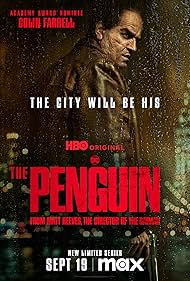The DC Studios logo is placed in a rainy Gotham alley
Chronology
Following the events of Batman (2022), Oz Cobb, aka the Penguin, takes on a role that aims to take over Gotham’s criminal underworld. From melting makeup to shooting in sub-zero temperatures, Colin Farrell and Cristin Milioti discuss what it was like to get into character during the production of Penguin. Colin Farrell fought hard to get his version of the Penguin to smoke tobacco in Batman (2022), but to no avail. However, in his own series, the character is portrayed as an occasional tobacco user who prefers cigars. The umbrella falls and the logo changes to the Warner Bros.
Graham Norton likes: Lady Gaga/Demi Moore/Colin Farrell/Richard Ayoade/Jack Savoretti (2024)
logo. HBO’s new series The Penguin, a spin-off from Matt Reeves’ Batman (2022), is a thrilling dive into Gotham City’s criminal underworld. Directed by Colin Farrell as the titular character Oswald Cobblepot, aka The Penguin, the series expands on the gritty, noir tone of the film and offers fans a fresh, yet familiar experience in the world of Batman. Unlike most superhero content, The Penguin focuses on the darker, more human aspects of Gotham’s criminals, moving away from the caped crusader to focus on the rise of one of Batman’s most famous foes. Set immediately after the events of The Batman, the series follows The Penguin’s journey to find power in the void left in Gotham’s criminal empire.
Colin Farrell’s performance of Penguin is simply extraordinary
With Carmine Falcone dead and Gotham’s infrastructure in disarray, Penguin seizes the opportunity to climb the ranks, determined to take control of the city’s crime syndicates. The focus is on his transformation from underboss to mastermind, giving Penguin the feel of a mob drama more reminiscent of The Sopranos than a traditional superhero show. The show cleverly avoids relying too much on Batman’s shadow, allowing Penguin to truly shine as a leader. Without the overbearing presence of Gotham’s protector, this creates a new and interesting dynamic in which Oswald is free to operate in a morally ambiguous space. This narrative shift freshens up the genre and adds depth to Gotham’s criminal world without becoming too much of a superhero spectacle.
The gritty atmosphere and tone
Physically unrecognizable in his prosthetic makeup, Farrell fully inhabits the character with a nuanced performance that balances the brutality of a mob boss with the insecurity and ambition that drives him. The Penguin is no longer just a caricature of a deformed villain with an umbrella; instead, he is presented as a ruthless, calculating player in Gotham’s criminal hierarchy, making him both terrifying and strangely likeable. Farrell brings layers to the character, going beyond the stereotypical portrayal of a villain. His Oswald Cobblepot is cunning, manipulative, and ready to break bones, yet a man driven by a deep-seated inferiority complex and a thirst for respect. Watching him navigate the treacherous waters of Gotham’s criminal world is fascinating, and provides a solid approach to the character that makes “Penguin” a fascinating character study.
The tone of the series is grim, brutal, and tense, reminiscent of neo-noir crime thrillers
In terms of atmosphere, “Penguin” maintains the same gritty, rainy aesthetic that fans have come to love in “The Batman.” The dark, crime-ridden streets of Gotham are beautifully filmed, with an emphasis on realism over comic-book extravagance. Every scene is permeated with the corruption and decay of Gotham, and it seems that danger lurks in every shadow. The production design is top-notch, with the sets feeling like a natural extension of Reeves’ film. Gotham City. Segregious clubs, run-down alleys, and opulent criminal mansions all add to the immersive atmosphere of the series.


